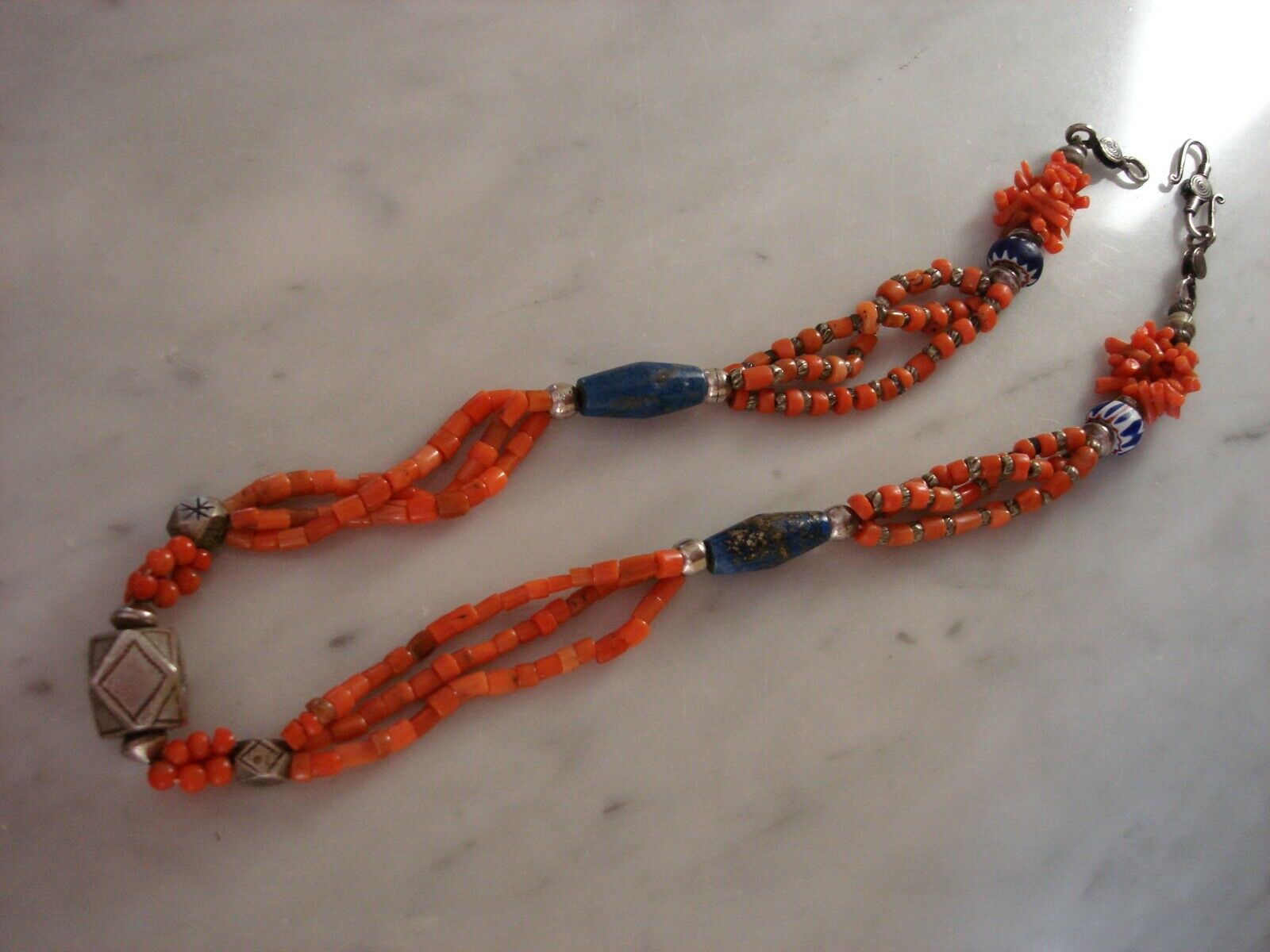-40%
Idar Oberstein Old Trade Carnelian Berber Hirz Venetian Tagmoute Tribal Necklace
$ 123.55
- Description
- Size Guide
Description
Moroccan Berber Hirz Enameled Amazigh Tiznit Tifinagh Venetian glass coin antique pendant & Ethnic Tagmoute silver egg beads with Idar Oberstein old trade vintage old carnelian rectangular beads handmade necklace.Authentic Moroccan enameled green and orange Hirz coin pendant with 3 vintage coins and Venetian glass accents.
Hirz pendant measures 3” in height including coins and 1.5” in width.
Necklace measures 23.5” in length.
Tagmoute silver eggs enameled with green and orange and measure 32mm by 30mm.
Each bead has been individual crafted by a master artisan in a village of south central Morocco. The rich enamel colors on the surface of each bead are unique.
Multiple Moroccan silver bicone beads and a silver hook clasp.
Beautiful vintage old rectangular Carnelian beads are 12mm by 22mm.
Carnelian is said to aid health, long life and good fortune. It is also said to help one fulfil ones innermost wishes if worn near the heart. Warming and cleansing the blood and kidneys this stone works well in the orange and yellow. This stone can also be used to stimulate appetite, passion, emotions and physical energy.
Like the unexpected fire of a sunset, or the first flash of autumn brilliance, Carnelian captivates. Its bold energy brings a rush of warmth and joy that lingers, stimulating and empowering. Known as a stone of motivation and endurance, leadership and courage, Carnelians have protected and inspired throughout history.
A glassy, translucent stone, Carnelian is an orange-colored variety of Chalcedony, a mineral of the Quartz family. Its color varies from pale pinkish-orange to a deep rusty brown, though it is most known for its brilliant orange and red-orange crystals. Its name comes from a Latin word meaning "flesh."
In antiquity, as well as today, Carnelian is believed to help timid speakers become both eloquent and bold. Ancient Warriors wore Carnelian around their neck for courage and physical power to conquer their enemies. In Egypt it was worn by master architects to show their rank of builder, and alchemists of the Middle Ages used it as a boiling stone to activate the energy of other Chalcedonies.
The ancient Egyptians called Carnelian "the setting sun." In its orange hues, they identified it with the receptive or passive female energies, and associated it with the fertile menstrual blood of the mother goddess, Isis. In its red, red-orange to reddish brown shades, they considered it the active male energy stone, recognized by its glowing vibrant color. Carnelian is traditionally worn to enhance passion, love, and desire.
Tagmoute egg is a classic silver enamelled egg bead. These beads were used in necklaces and fibula chains by Berber ladies, the egg of course symbolises fertility and new birth. The yellow and green enamel is made from venetian glass trade beads and is characteristically somewhat rough in execution.
An old Berber silver metal and enamel egg bead (Tagmoute) sourced in Ida ou Semlal in the Western Anti Atlas in Southern Morocco. Among the Berber the egg is a symbol of fertility, as life comes from it. Hand made in the first half of the 20th century, with enameling in blue, yellow and red. This would typically be worn at the center of linked fibulae or on necklaces. The repeated eye design is believed to be a strong protective element for the wearer.
The Berbers or Imazighen (‘Free people’; plural of Amazigh) are the original inhabitants of North Africa. They speak a number of related languages and share a common cultural heritage. Most Berbers nowadays live in Morocco, Algeria, Tunisia, Libya, Mali, Mauritania and Niger.
In Berber culture, jewelry has a symbolic and mythical meaning besides their practical and ornamental function, as they are used as charms and talismans to protect against evil spirits and influences. In addition, acquiring jewelry has an economic meaning. An Amazigh woman’s jewelry is her private property. She may buy, and then later sell jewelry to support her family in dire economic times. With the money she might also buy cattle or land. Smart commercial use makes women apt family bankers.
Berbers call themselves some variant of the word i-Mazigh-en (singular: a-Mazigh), possibly meaning "free people" or "noble men". The name probably had its ancient parallel in the Roman and Greek names for Berbers, Mazices.
The berber language (Tamazight) is one of the oldest languages of humanity. Nowadays, it is spoken by the people of North Africa , Egyptian oasis of Siwa and the Touaregs in the Sahara (desert).
From Central Atlas Tamazight ⴰⵎⴰⵣⵉⵖ (amazi
ɣ
). From the active participle ⴰⵎ (am) and ⴰⵣⵉⵖ (azi
ɣ
), whose meaning is unknown but is possibly related to "aze" ("to be strong" in Taznatit), or perhaps "je
ɣ
e
ɣ
" ("to be brave" in Tamasheq); z and j frequently swap out in The Berber are the indigenous people of North Africa, west of the Nile Valley. Many Berbers call themselves some variant of the word Imazighen(singular: Amazigh), possibly meaning "free people" or "free and noble men". The word has probably an ancient parallel in the Roman name for some of the Berber, "Mazices".
The name Berber comes from the name given to this people by the Romans, meaning barbarians. The history of the Berber people in northern Africa is both extensive and diverse. Their oldest ancestors settled in the East of Egypt.




















